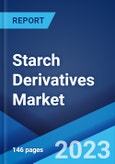Starch derivatives refer to a group of organic compounds derived from starch, a complex carbohydrate found in plants. It includes modified starch, cyclodextrin, starch esters, glucose syrup, maltodextrin, and hydrolysates. They are commercially produced by modifying starch using chemical, physical, and enzymatic methods. Starch derivatives are widely used in cooking, dairy products, drug formulations, intravenous solutions, paper manufacturing, printing, cosmetics, personal care products, adhesive, and biodegradable packaging. They are cost-effective, safe, and versatile substances that enhance the texture and flavor of food, improve binding properties, enhance solubility, and increase the strength, smoothness, and surface properties of various materials. They are also renewable and biodegradable in nature, which aids in reducing adverse environmental impacts, promoting sustainability, and minimizing reliance on fossil fuel-based alternatives. As a result, starch derivatives find extensive applications across the food and beverage (F&B), cosmetics, pharmaceuticals, textile, printing, papermaking, and packaging industries.
Starch Derivatives Market Trends:
The rising product utilization in the F&B industry is one of the primary factors propelling the market growth. Starch derivatives are widely used as a thickening, emulsifying, stabilizing, and encapsulating agent in sauces, salad dressings, soups, desserts, mayonnaise, and dairy products, which aids in improving texture, increasing stability, and preserving flavor, fragrances, and nutrients. Along with this, the growing demand for convenience and fast-food products due to changing dietary preferences of consumers is acting as another growth-inducing factor. Furthermore, the widespread product adoption in the pharmaceutical industry as an excipient and drug delivery system to improve binding, solubility, stability, bioavailability, and controlled release properties of capsules, tablets, and other formulations is providing an impetus to the market growth. Additionally, the introduction of enzymatic methods, which involves the utilization of various enzymes in the manufacturing process, such as amylase, pullulanase, and cyclodextrin glycosyltransferases (CGTases) that provides high selectivity, increases yield, enhances production efficiency, and improves functionalities is positively influencing the market growth. Besides this, the growing product utilization to produce biodegradable packaging, which is eco-friendly and offers high flexibility, durability, strength, and barrier properties, is favoring the market growth. Moreover, the increasing product application in the manufacturing of various cosmetics and personal care products, such as lotions, creams, shampoos, diapers, and sanitary pads, is contributing to the market growth. Other factors, including growing demand for clean labels and natural ingredients, extensive research and development (R&D) activities, and rising health consciousness among the masses, are anticipated to drive the market growth.Key Market Segmentation:
The publisher provides an analysis of the key trends in each segment of the global starch derivatives market, along with forecasts at the global, regional, and country levels from 2025-2033. Our report has categorized the market based on product and application.Product Insights:
- Maltodextrin
- Glucose Syrup
- Cyclodextrin
- Hydrolysates
- Modified Starch
- Others
Application Insights:
- Food and Beverages
- Cosmetics
- Paper
- Pharmaceuticals
- Feed
- Others
Regional Insights:
- North America
- United States
- Canada
- Asia Pacific
- China
- Japan
- India
- South Korea
- Australia
- Indonesia
- Others
- Europe
- Germany
- France
- United Kingdom
- Italy
- Spain
- Russia
- Others
- Latin America
- Brazil
- Mexico
- Others
- Middle East and Africa
Competitive Landscape:
The report has also provided a comprehensive analysis of the competitive landscape in the global starch derivatives market. Detailed profiles of all major companies have been provided. Some of the companies covered include Agrana Group (AGRANA Zucker Stärke und Frucht Holding AG), Archer Daniels Midland Company, Cargill Incorporated, Foodchem International Corporation, Grain Processing Corporation (Kent Corporation), Ingredion Incorporated, JP & SB International, Matsutani Chemical Industry Co., Ltd., Roquette Frères, ShreeGluco Biotech Private Ltd., Tate & Lyle PLC, Tereos S.A, etc. Kindly note that this only represents a partial list of companies, and the complete list has been provided in the report.Key Questions Answered in This Report
- How big is the starch derivatives market?
- What is the future outlook of starch derivatives market?
- What are the key factors driving the starch derivatives market?
- Which region accounts for the largest starch derivatives market share?
- Which are the leading companies in the global starch derivatives market?
Table of Contents
Companies Mentioned
- Agrana Group (AGRANA Zucker Stärke und Frucht Holding AG)
- Archer Daniels Midland Company
- Cargill Incorporated
- Foodchem International Corporation
- Grain Processing Corporation (Kent Corporation)
- Ingredion Incorporated
- JP & SB International
- Matsutani Chemical Industry Co. Ltd.
- Roquette Frères
- ShreeGluco Biotech Private Ltd.
- Tate & Lyle PLC
- Tereos S.A
Table Information
| Report Attribute | Details |
|---|---|
| No. of Pages | 137 |
| Published | March 2025 |
| Forecast Period | 2024 - 2033 |
| Estimated Market Value ( USD | $ 58.8 Billion |
| Forecasted Market Value ( USD | $ 94.1 Billion |
| Compound Annual Growth Rate | 5.4% |
| Regions Covered | Global |
| No. of Companies Mentioned | 12 |









